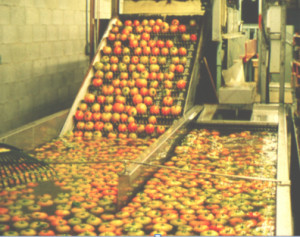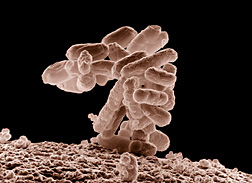In the past decade, leafy greens have been implicated in several outbreaks of foodborne illness, and research has focused on contamination during preharvest operations. Concerns have been raised that internalization of pathogens into the edible tissue occurs where postharvest chemical interventions would be ineffective. This study was initiated to measure the  degree and fate of Escherichia coli O157:H7 internalized in the phyllosphere tissue of leafy greens when spray conditions, inoculum level, and type of leafy green were varied. Two spraying treatments were applied: (i) spraying individual spinach or lettuce leaves on plants once with a high dose (7 to 8 log CFU/ml) of E. coli O157:H7 and (ii) spraying spinach, lettuce, or parsley plants repeatedly (once per minute) with a low dose (2.7 to 4.2 log CFU/ml) of E. coli O157:H7 over a 10- to 20-min period. With the high-dose spray protocol, no significant differences in the prevalence of internalization occurred between Shiga toxin–negative E. coli O157:H7 isolates and virulent isolates (P > 0.05), implying that the Shiga toxin virulence factors did not influence internalization or the subsequent fate of those populations under these test conditions. Significantly greater internalization of E. coli O157:H7 occurred in spinach leaves compared with lettuce leaves when leaves were sprayed once with the high-dose inoculum (P < 0.05), whereas internalization was not observed in lettuce leaves but continued to be observed in spinach and parsley leaves following repeated spraying of the low-dose inoculum. Based on these results, it is surmised that a moisture film was generated when spraying was repeated and this film assisted in the mobilization of pathogen cells to plant apertures, such as stomata. E. coli O157:H7 cells that were internalized into spinach tissue using a low-dose repeat-spray protocol were temporary residents because they were not detected 2 days later, suggesting that plant-microbe interactions may be responsible.
degree and fate of Escherichia coli O157:H7 internalized in the phyllosphere tissue of leafy greens when spray conditions, inoculum level, and type of leafy green were varied. Two spraying treatments were applied: (i) spraying individual spinach or lettuce leaves on plants once with a high dose (7 to 8 log CFU/ml) of E. coli O157:H7 and (ii) spraying spinach, lettuce, or parsley plants repeatedly (once per minute) with a low dose (2.7 to 4.2 log CFU/ml) of E. coli O157:H7 over a 10- to 20-min period. With the high-dose spray protocol, no significant differences in the prevalence of internalization occurred between Shiga toxin–negative E. coli O157:H7 isolates and virulent isolates (P > 0.05), implying that the Shiga toxin virulence factors did not influence internalization or the subsequent fate of those populations under these test conditions. Significantly greater internalization of E. coli O157:H7 occurred in spinach leaves compared with lettuce leaves when leaves were sprayed once with the high-dose inoculum (P < 0.05), whereas internalization was not observed in lettuce leaves but continued to be observed in spinach and parsley leaves following repeated spraying of the low-dose inoculum. Based on these results, it is surmised that a moisture film was generated when spraying was repeated and this film assisted in the mobilization of pathogen cells to plant apertures, such as stomata. E. coli O157:H7 cells that were internalized into spinach tissue using a low-dose repeat-spray protocol were temporary residents because they were not detected 2 days later, suggesting that plant-microbe interactions may be responsible.
Journal of Food Protection®, Number 5, May 2014, pp. 696-863 , pp. 713-721(9)
Erickson, Marilyn C.1; Webb, Cathy C.2; Davey, Lindsey E.2; Payton, Alison S.2; Flitcroft, Ian D.3; Doyle, Michael P.2


.jpg) subsequent internalization has been a large area of research with results varying due to differences in experimental design, systems tested, and pathogens and crops used.
subsequent internalization has been a large area of research with results varying due to differences in experimental design, systems tested, and pathogens and crops used. .jpg) coli—including some highly pathogenic strains that cause foodborne illness—by adding a gene for fluorescence. This allowed them to track the pathogen’s journey from the field to the produce.
coli—including some highly pathogenic strains that cause foodborne illness—by adding a gene for fluorescence. This allowed them to track the pathogen’s journey from the field to the produce. produce outbreak O157:H7 strains RM4407 and RM5279 (inoculum 1), ground beef outbreak O157:H7 strain 86-24h11 (inoculum 2), and commensal strain HS (inoculum 3). These strains were cultivated in fecal slurries and applied at ca. 10(3) or 10(7) CFU/g to pasteurized soils in which baby spinach seedlings were planted. No E. coli was recovered by spiral plating from surface-sanitized internal tissues of spinach plants on days 0, 7, 14, 21, and 28. Inoculum 1 survived at significantly higher populations (P < 0.05) in the soil than did inoculum 3 after 14, 21, and 28 days, indicating that produce outbreak strains of E. coli O157:H7 may be less physiologically stressed in soils than are nonpathogenic E. coli isolates. Inoculum 2 applied at ca. 10(7) CFU/ml to hydroponic medium was consistently recovered by spiral plating from the shoot tissues of spinach plants after 14 days (3.73 log CFU per shoot) and 21 days (4.35 log CFU per shoot). Fluorescent E. coli cells were microscopically observed in root tissues in 23 (21%) of 108 spinach plants grown in inoculated soils. No internalized E. coli was microscopically observed in shoot tissue of plants grown in inoculated soil. These studies do not provide evidence for efficient uptake of E. coli O157:H7 from soil to internal plant tissue.
produce outbreak O157:H7 strains RM4407 and RM5279 (inoculum 1), ground beef outbreak O157:H7 strain 86-24h11 (inoculum 2), and commensal strain HS (inoculum 3). These strains were cultivated in fecal slurries and applied at ca. 10(3) or 10(7) CFU/g to pasteurized soils in which baby spinach seedlings were planted. No E. coli was recovered by spiral plating from surface-sanitized internal tissues of spinach plants on days 0, 7, 14, 21, and 28. Inoculum 1 survived at significantly higher populations (P < 0.05) in the soil than did inoculum 3 after 14, 21, and 28 days, indicating that produce outbreak strains of E. coli O157:H7 may be less physiologically stressed in soils than are nonpathogenic E. coli isolates. Inoculum 2 applied at ca. 10(7) CFU/ml to hydroponic medium was consistently recovered by spiral plating from the shoot tissues of spinach plants after 14 days (3.73 log CFU per shoot) and 21 days (4.35 log CFU per shoot). Fluorescent E. coli cells were microscopically observed in root tissues in 23 (21%) of 108 spinach plants grown in inoculated soils. No internalized E. coli was microscopically observed in shoot tissue of plants grown in inoculated soil. These studies do not provide evidence for efficient uptake of E. coli O157:H7 from soil to internal plant tissue.